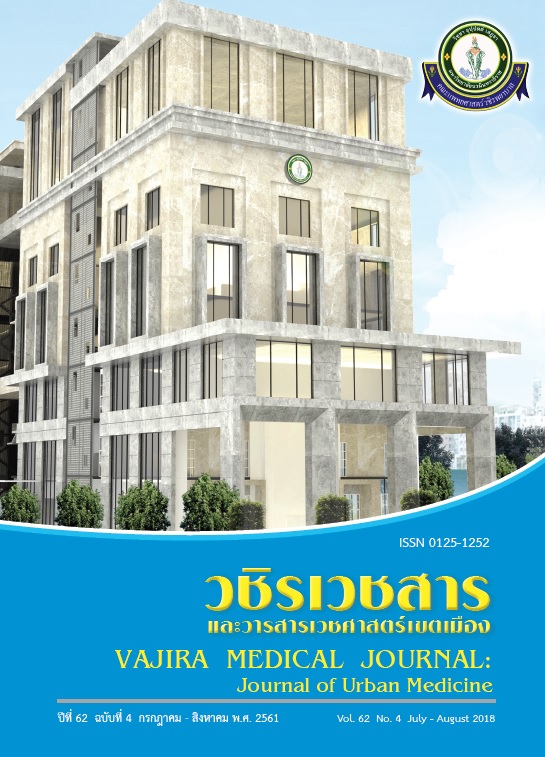Public mind in Medical School: A Comparison of 1st-3rd Year Medical Students at Faculty of Medicine Vajira Hospital
Main Article Content
Abstract
Objective: To examine and compare the public mind of medical students at Faculty of Medicine Vajira hospital, Navamindradhiraj University.
Methods: This is a descriptive study. The subjects were 195 medical students in academic year 2015 composing 67 first-year, 76 second-year, and 52 third-year medical students. The instrument used for collecting data was a Likert-type, five-point rating scale questionnaire of 20 items on public mind. The data were analyzed by using descriptive statistic methods such as mean, percentage, and standard deviation.
Results: The results revealed that the 1st-3rd year medical students had high level of public mind in both overall and individual aspects. As each aspect was determined, the highest rated aspect was avoiding destruction of public; the second rank was public respect; and the lowest aspect was responsible for the maintenance. Public mind in the 1st and 2nd year medical student was not significantly different, whereas in the 3rd year medical student was lower than other years. However, there is no difference on their public mind in other factor such as gender and grade point average.
Conclusion: The result suggested that the level of public mind declined in higher educational levels among medical students.
Downloads
Article Details
References
2. Jakpisut S. Public consciousness. Art and culture 2001; 20(3): 22-3.
3. Magnusson D, Endler NS. Personality at the cross-roads: Current issues in interactiorud psychology. Hillsdale, N.J.: Lawrence Eribaum Associates, Inc., 1977.
4. Thai Qualifications Framework for Higher Education. [internet] 2017 [cited 2017 Aug 10]. Available from: http://www.mua.go.th/users/tqf-hed/news/FilesNews/FilesNews3/News328072552.pdf.
5. Nutchad M. Environmental factors in schools affecting public mind behaviors of prathom sueksa six students under the Samut Sakhon primary educational service area office [dissertation].Ramkamhaeng University; 2010.
6. Kampan A, Sakulku J, Phothisook A, Phutiariyawat J. A Study of Factor Analysis of Public Consciousness of University’s Students in Bangkok Area. Journal of Social Sciences Srinakharinwirot University 2015; 18: 299-313.
7. Vongmonta A. Factors affecting towards public mind of Prince of songkla university's students [dissertation]. Prince of Songkla University; 2010.
8. Namarak R. Analysis of composition of public minds of students in Ramkhamhaeng University student organization [dissertation]. Ramkhamhaeng University; 2009.
9. Yodsuwan B. Level of public consciousness of Mae Fah Luang University undergrade students. [dissertation]. Mae Fah Luang University; 2013.
10. Office of the National Economic and Social Development Board. National Economic and Social Development Plan Eleventh edition (2012-2016). [internet]. 2017 [cited 2017 Aug 10].Available from: http://www.nesdb.go.th/download/article/ article_20160323112431.pdf.
11. Chatreekul V. Leadership Training for Social Workers. [internet]. 2017 [cited 2017Aug 10]. Available from: http://www.changemakers. com/en/project/ volunteer activist training for the community.
12. Devatadin Na Ayudhya W. Moral Development of Student Ethics. Bangkok: Printing House, 2000.
13. Chuabangkaew P. Personality development. 11st ed. Pathumthani: Bangkok University; 2010.
14. Moonmuang J. A comparison of social responsibility levels of students in different fields of studies [dissertation]. Psychology: Chulalongkorn University; 1992.
15. Cheng, Wan Hua; & Khoo, Ee Wan. Research Report: Civic Mindedness Components, Correlates and Implications for the Public Service. Singapore: Civil Service College; 2011.


